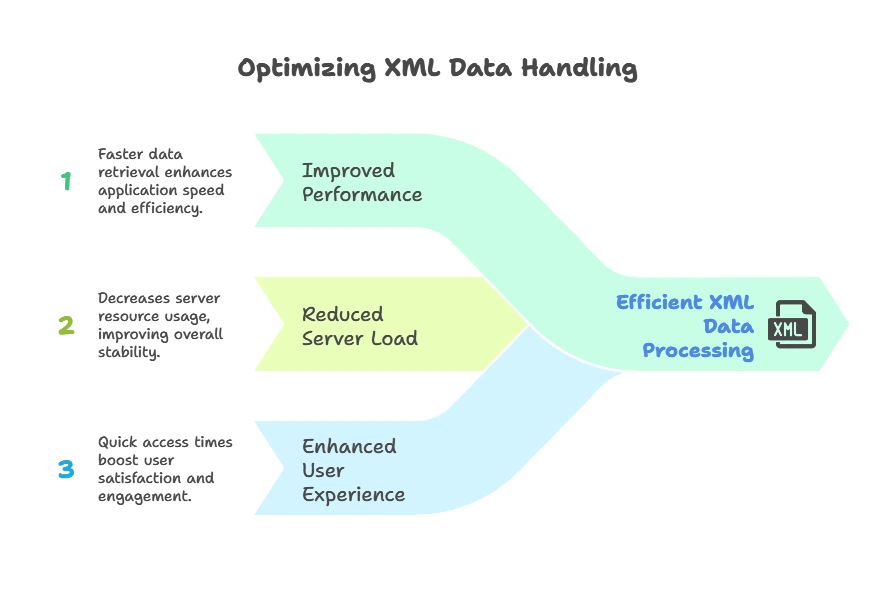Caching XML Data for Processing
In this chapter, we will explore how caching XML data can significantly enhance the performance and efficiency of XML-based applications. Caching allows frequently accessed XML data to be stored temporarily in memory or on disk, reducing processing time and improving response times. This chapter provides a comprehensive overview, from the basics of caching to advanced techniques, with examples to clarify each concept.
Introduction to XML Caching
XML data is often used in applications due to its structured, hierarchical format, making it versatile for data storage and transfer. However, parsing and processing XML data repeatedly can be resource-intensive, particularly with large datasets. Caching involves storing the processed XML data in a temporary storage location, making it quickly accessible without the need for repeated parsing.
Benefits of Caching XML Data:
- Improved Performance: Cached data can be retrieved faster than reprocessing the XML.
- Reduced Server Load: Minimizes the resources needed for frequent XML parsing.
- Enhanced User Experience: Faster access times result in better application responsiveness.

Types of Caching in XML Processing
In-Memory Caching
In-memory caching stores XML data directly in the RAM, making it extremely fast to access. This method is well-suited for data that requires frequent, quick access and does not change often.
- Pros: Very fast access; ideal for high-frequency, small-to-medium data.
- Cons: Limited by system memory; data is lost if the system restarts.
Disk-Based Caching
Disk-based caching involves storing XML data on a disk (like a hard drive or SSD). This caching method is more stable than in-memory caching, as data persists even if the system reboots.
- Pros: Persistent storage; better suited for large data.
- Cons: Slower than in-memory caching; depends on disk speed.
Strategies for XML Data Caching
Full XML Document Caching
The entire XML document is stored in cache, and each time a request is made, the cached copy is served. This is efficient if the XML document is requested frequently and doesn’t change often.
Example Code for Full Document Caching (Python):
import xml.etree.ElementTree as ET
# Original XML data
xml_data = '''<Library><Book><Title>Book A</Title></Book></Library>'''
# Caching the full document in memory
cache = {}
if "library_data" not in cache:
cache["library_data"] = ET.ElementTree(ET.fromstring(xml_data))
# Retrieving from cache
cached_xml = cache["library_data"]
for book in cached_xml.findall('.//Book'):
print(book.find('Title').text) # Output: Book A
In this code:
- We store the XML document in the
cachedictionary. - Whenever we need to access it, we retrieve it directly from the cache without parsing again.
Partial Caching (Selective Caching)
With partial caching, only certain sections of the XML data are cached. This approach is useful for large XML documents where only specific elements are frequently accessed.
Example Code for Partial Caching:
# Assuming a large XML structure
xml_data = '''<Library><Book id="1"><Title>Book A</Title></Book></Library>'''
# Cache only the 'Title' elements for faster access
title_cache = {}
root = ET.fromstring(xml_data)
for book in root.findall('.//Book'):
book_id = book.get('id')
title_cache[book_id] = book.find('Title').text
# Accessing cached titles
print(title_cache["1"]) # Output: Book A
Here, we store only the <Title> elements in title_cache, which optimizes memory usage and processing time.
Methods for Implementing Historical Queries
Using Redis for XML Caching
Redis, a fast, in-memory database, is commonly used for caching purposes. Redis allows storing XML strings or serialized objects and provides features like data persistence and expiration.
Example of Redis-Based XML Caching (Python with redis library):
import redis
import xml.etree.ElementTree as ET
# Connect to Redis
r = redis.Redis()
# Store XML data in Redis
xml_data = '''<Library><Book><Title>Book A</Title></Book></Library>'''
r.set('library_data', xml_data)
# Retrieve XML data from Redis
cached_data = r.get('library_data')
root = ET.fromstring(cached_data)
# Process the XML
for book in root.findall('.//Book'):
print(book.find('Title').text) # Output: Book A
Explanation:
- The XML data is stored in Redis under the key
library_data. - We retrieve and parse it when needed, reducing the load on the primary database or server.
Using Memcached for XML Caching
Memcached is another caching solution focused on speed and efficiency. It is ideal for storing frequently accessed XML data temporarily.
Basic Example of XML Caching with Memcached:
import memcache
import xml.etree.ElementTree as ET
# Connect to Memcached
mc = memcache.Client(['127.0.0.1:11211'])
# Store XML data
xml_data = '''<Library><Book><Title>Book A</Title></Book></Library>'''
mc.set('library_data', xml_data)
# Retrieve XML data
cached_data = mc.get('library_data')
root = ET.fromstring(cached_data)
# Output title
for book in root.findall('.//Book'):
print(book.find('Title').text) # Output: Book A
Memcached caches the XML as a string, which can then be retrieved and parsed. This approach helps improve application performance and reduces latency.
Advanced Caching Techniques for XML Data
Expiration and Invalidation Policies
Setting an expiration policy ensures that stale data is automatically removed from the cache. This is particularly useful for XML data that may be updated frequently.
Example: Using Redis, we can set an expiration time on keys
r.set('library_data', xml_data, ex=60) # Expires in 60 seconds
Data Serialization for Efficient Storage
Serialized XML data can be stored more efficiently in cache. Serialization involves converting the XML data structure into a format suitable for quick storage and retrieval.
Best Practices for XML Caching
- Cache Wisely: Only cache data that is frequently accessed and not subject to frequent changes.
- Use Expiration: Set expiration times on cache entries to prevent serving outdated data.
- Leverage Key-Value Stores: For highly accessed XML data, use in-memory key-value stores like Redis or Memcached.
Caching XML data is a powerful way to optimize applications that rely on frequent XML processing. By leveraging in-memory or disk-based caching, developers can significantly improve the efficiency and performance of XML data handling. The best caching approach depends on the application's requirements, but the key is to find a balance between quick access and data freshness. With the strategies discussed here, you can implement a robust caching mechanism to make your XML-dependent applications faster and more scalable. Happy coding !❤️
